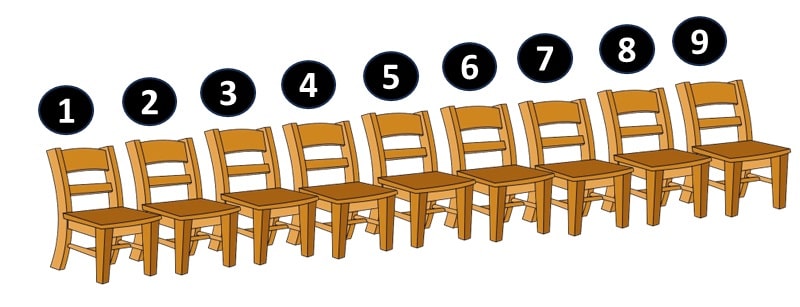Q) In a school examination hall, the teacher makes students sit in such a way that no students can cheat from other student. So, the teacher decides to mark the numbers on each chair from 1. 2. 3…….
If there are 26 students and each student is seated at alternate position in examination hall such that the sequence formed is 1, 3, 5. Based on the above information, answer the following questions:
i. Find the common difference between two seats.
ii. What type of sequence is formed, to follow the seating arrangement of students in the examination hall?
iii. Find the seat number of the last student in the examination hall.
iv. Find the seat number of the 10th vacant seat in the examination hall.
Ans: It is given that the seats are numbered in sequence and 26 students are being seated on alternate seats.

Let’s start solving the questions.
i. Common Difference:
It is given that 1st student is given seat no. 1, the next student gets seat no. 3, the next student gets seat no. 5, and so on…..
Hence, the difference between the first 2 consecutive seats is: 3 -1 = 2
Similarly, the difference between the next 2 seats is 5-3 = 2.
Since this difference is common across the seats, hence it is a common difference.
Hence, the Common difference between the two seats is 2.
ii. Type of sequence:
Since Students are being seated at seat nos. 1, 3, 5, ….. with a common difference of 2.
This sequence is an AP of all odd integers.
It has the following characteristics:
# Its first term, a1 = 1
# Its common difference, d = 2
# This AP will have a total of 26 terms, which is equal to no. of students.
iii. Seat number of the last student:
Since the last student is the 26th student, and seat numbers are in AP
Hence, the seat no. of this student will be the value of the 26th term of this AP.
In an AP, nth term Tn = a + (n – 1) d
∴ T26 = 1 + (26 – 1) (2)
= 1 + 25 x 2
= 51
Therefore, the last student will sit in 51 no. seat.
[ Note for Students: This AP is of odd integers and hence value of each term will be odd. If your answer is even, recheck your solution.]
iv. Seat Number of 10th vacant seat:
We can see that 1st student sits on the 1st seat, then 2nd seat goes vacant, 2nd student comes on the 3rd seat and then the 4th seat goes vacant and so on…
It means 1st vacant seat comes after 1st student, 2nd vacant seat comes after 2nd student, and so on…
Hence, the 10th vacant seat will come after the 10th student.
Therefore, if we find out the seat number of the 10th student, we need to add 1 to get seat no. of our 10th vacant seat.
Now, the seat number of the 10th student will be the value of the 10th term of our AP.
We know that, in an AP, nth term Tn = a + (n – 1) d
∴ T10 = 1 + (10 – 1) (2)
= 1 + 9 x 2
= 19
∴ The 10th student occupies 19 number seat and the 10th Vacant seat will be next to 10th student.
∴ seat number of 10th vacant seat = 19 + 1 = 20
Hence, the number of 10th vacant seat is 20.
[ Note for Students: This vacant seat number is next to the seat occupied by a student. It will be an even number. Recheck your solution, if your answer is an odd no.]
Please do press “Heart” button if you liked the solution.
